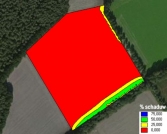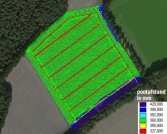Step 6: Variable planting
The seed potatoes are expensive, so the growers want to get the maximum yield. There are three ways of variable planting in a field..
Spray paths
We use tramlines to carry out crop care. The 1st and 4th rows of the pass are omitted when planting to create a spray path. These spray paths comprise approximately 5.5% of the total cultivation area of Van den Borne.
The potato plants next to the spray path receive more light, nutrients and water, which means that these plants have a higher yield potential. When spray paths are created, the planting machine switches off the first and fourth rows. This creates two rows that are not planted, these unplanted rows form the spray paths. In addition, the potatoes in the two inner rows are planted 10% closer together.
Shadows through trees
In the shaded areas there is less light, so the yield per plant is lower. By planting fewer potatoes in this zone, more light, water and minerals are available per plant. This leads to a higher yield per plant and lower costs for the seed potatoes, resulting in a higher financial yield.
The variable planting is applied as follows:
- Zone 100% light: normal {plant distance}
- Zone 75% light: planting distance extended by 10%
- Zone 50% light: planting distance extended by 20%
- Zone 25% light: planting distance extended by 30%
Below you see a shadow map of one of our plots in figure 1. The leg distance map is also shown in Figure 2.
Soil zones
Before the season, these soil zones are mapped by means of a soil scan. This soil scan shows different zones in a plot with low and high conductivity. Zones with higher conductivity have a higher yield potential under average growing conditions. In places where there is a higher conductivity, there is denser planting because there is more soil moisture in these places. By adjusting the planting distance in these places to the yield potential, the highest possible yield can be achieved with an optimal amount of seed potatoes.





















Social media
Bezoekers online: 50